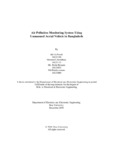| dc.contributor.advisor | Sabuj, Saifur Rahman | |
| dc.contributor.author | Al-Farabi, Md. | |
| dc.contributor.author | Chowdhury, Muntasir | |
| dc.contributor.author | Hossain, Md. Rafat | |
| dc.contributor.author | Readuzzaman, Md. | |
| dc.date.accessioned | 2020-02-05T05:40:17Z | |
| dc.date.available | 2020-02-05T05:40:17Z | |
| dc.date.copyright | 2019 | |
| dc.date.issued | 2019-12 | |
| dc.identifier.other | ID 16121104 | |
| dc.identifier.other | ID 16121113 | |
| dc.identifier.other | ID 16121053 | |
| dc.identifier.other | ID 16121080 | |
| dc.identifier.uri | http://hdl.handle.net/10361/13735 | |
| dc.description | This thesis is submitted in partial fulfillment of the requirements for the degree of Bachelor of Science in Electrical and Electronic Engineering, 2019. | en_US |
| dc.description | Cataloged from PDF version of thesis. | |
| dc.description | Includes bibliographical references (pages 51-53). | |
| dc.description.abstract | Over the last few decades, the main minacious and dodgy calamity that grab the world’s attention is “Greenhouse Effect”. It is evident that Carbon dioxide, methane, nitrous oxide, fluorinated gasses and water vapor are the common phenomenon causing this disaster. These gasses remain in the atmosphere causing the temperature to rise as the sunlight can pass through the ozone layer, but they can’t go back and trap inside the earth atmosphere. Being great concern to the future world, this proposal emphasizes on collecting data from the atmosphere and predicting future temperature and amount of gasses with the help of an Unmanned Aerial Vehicle (UAV) system. This system is designed as a comprised of sensors and database system. With the help of the drone which carries humidity sensor DHT11, gas sensors MQ2, MQ7, MQ135 along with temperature sensor TCH11, TCH22. The data that is needed for the further prediction will be collected by the help of these sensors. Node MCU will also be used. It will relate to Arduino Nano. With the help of Wi-Fi system all the data will be stored into a server. Based on the data, real-time graph for individual aspects will be plotted in an interface for better visualization, which will be helpful for monitoring and analysis. For the future prediction regression model is chosen and suggested values are compared. From the collecting values, if difference is much higher along with crossing the safe threshold limit. This proposal aims to identify the impact of “Green House” in a region and claims to raise awareness. | en_US |
| dc.description.statementofresponsibility | Md. Al-Farabi | |
| dc.description.statementofresponsibility | Muntasir Chowdhury | |
| dc.description.statementofresponsibility | Md. Rafat Hossain | |
| dc.description.statementofresponsibility | Md. Readuzzaman | |
| dc.format.extent | 53 pages | |
| dc.language.iso | en | en_US |
| dc.publisher | Brac University | en_US |
| dc.rights | Brac University theses are protected by copyright. They may be viewed from this source for any purpose, but reproduction or distribution in any format is prohibited without written permission. | |
| dc.subject | Green house effect | en_US |
| dc.subject | Linear regression analysis | en_US |
| dc.subject | UAV | en_US |
| dc.subject | NodeMCU | en_US |
| dc.subject | Gas sensors | en_US |
| dc.subject.lcsh | Air--Pollution | |
| dc.subject.lcsh | Vehicles, Remotely piloted | |
| dc.title | Air pollution monitoring system using unmanned aerial vehicle in Bangladesh | en_US |
| dc.type | Thesis | en_US |
| dc.contributor.department | Department of Electrical and Electronic Engineering, Brac University | |
| dc.description.degree | B. Electrical and Electronic Engineering | |

